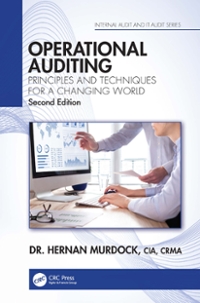Question
On January 1, Acme Aglet Corporation is contemplating a four-year, $3 million term loan from the Fidelity First National Bank. The loan is payable at

On January 1, Acme Aglet Corporation is contemplating a four-year, $3 million term loan from the Fidelity First National Bank. The loan is payable at the end of the fourth year and would involve a loan agreement that would contain a number of protective covenants. Among these restrictions are that the company must maintain net working capital (current assets minus current liabilities) of at least $3 million at all times, that it cannot take on any more long-term debt, that its total liabilities cannot be more than 0.6 of its total assets, and that capital expenditures in any year are limited to depreciation plus $3 million. The companys balance sheet at December 31, before the term loan, is as follows (in millions): Current assets Net fixed assets Total $ 7 10 $17 Current liabilities Long-term debt (due in 8 years) Shareholders equity Total $ 3 5 9 $17 The proceeds of the term loan will be used to increase Acme Aglets investment in inventories and accounts receivables in response to introducing a new fit-to-be-tied metal aglet. The company anticipates a subsequent need to grow at a rate of 24 percent a year, equally divided between current assets and net fixed assets. Profits after taxes of $1.5 million are expected this year, and these profits are expected to grow by $250,000 per year over the subsequent three years. The company pays no cash dividends and does not intend to pay any over the next four years. Depreciation in the past year was $2.5 million, and this is predicted to grow over the next four years at the same rate as the increase in net fixed assets. Under the loan agreement, will the company be able to achieve its growth objective? Explain numerically.
. On January 1, Acme Aglet Corporation is contemplating a four-year, $3 million term loan from the Fidelity First National Bank. The loan is payable at the end of the fourth year and would involve a loan agreement that would contain a number of protective covenants. Among these restrictions are that the company must maintain net working capital (current assets minus current liabilities) of at least $3 million at all times, that it cannot take on any more long-term debt, that its total liabilities cannot be more than 0.6 of its total assets, and that capital expenditures in any year are limited to depreciation plus $3 million. The company's balance sheet at December 31, before the term loan, is as follows (in millions): Current assets Net fixed assets $ 7 10 Current liabilities Long-term debt (due in 8 years) Shareholders' equity Total Slono Total $17 The proceeds of the term loan will be used to increase Acme Aglet's investment in inven- tories and accounts receivables in response to introducing a new "fit-to-be-tied metal aglet. The company anticipates a subsequent need to grow at a rate of 24 percent a year, equally divided between current assets and net fixed assets. Profits after taxes of $1.5 million are expected this year, and these profits are expected to grow by $250,000 per year over the subsequent three years. The company pays no cash dividends and does not intend to pay any over the next four years. Depreciation in the past year was $2.5 million, and this is predicted to grow over the next four years at the same rate as the increase in net fixed assets. Under the loan agreement, will the company be able to achieve its growth objective? Explain numericallyStep by Step Solution
There are 3 Steps involved in it
Step: 1

Get Instant Access to Expert-Tailored Solutions
See step-by-step solutions with expert insights and AI powered tools for academic success
Step: 2

Step: 3

Ace Your Homework with AI
Get the answers you need in no time with our AI-driven, step-by-step assistance
Get Started


